Herb gardens in containers are a fantastic way to grow your favorite flavors without the need for a large backyard. Perfect for apartments, balconies, or even small patios, these little gardens can brighten up any space while providing fresh herbs right at your fingertips. Plus, they’re easy to maintain and allow you to mix and match different herbs to suit your culinary needs. Get ready to dig in!
Essential Herbs for Container Gardening
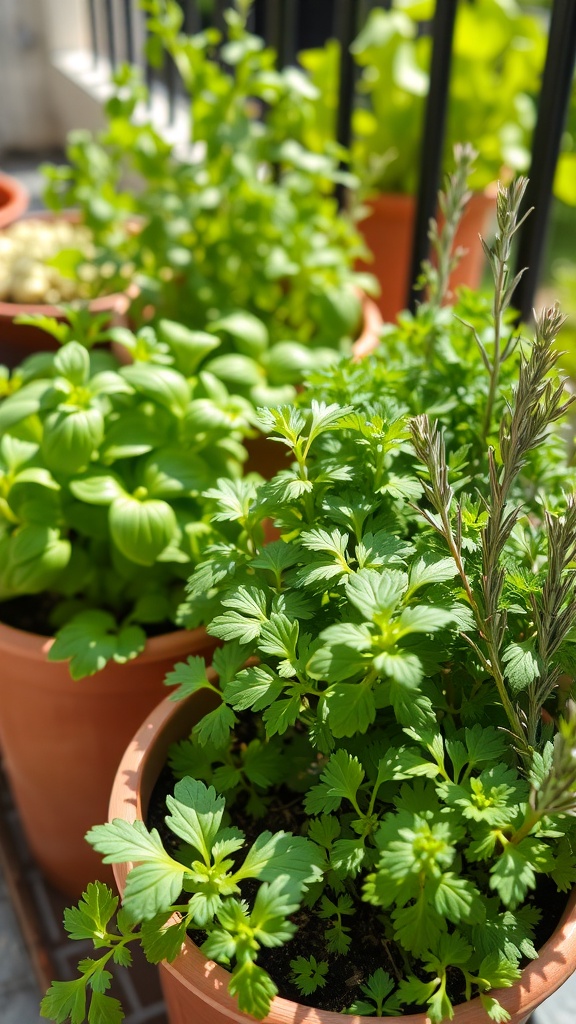
Container gardening is a fantastic way to grow herbs, especially if you have limited space. The image shows a variety of herbs thriving in pots, showcasing how easy it can be to cultivate fresh flavors right at home.
Some essential herbs for container gardening include basil, mint, and rosemary. Basil is perfect for adding to salads and pasta dishes. Its fragrant leaves can elevate any meal. Mint, on the other hand, is refreshing and great for teas or desserts. Rosemary adds a robust flavor to meats and roasted vegetables.
When choosing herbs, consider their growth habits. Some herbs, like mint, can spread quickly, so it’s best to keep them in their own pot. Others, like thyme and oregano, can share a container without any issues. Make sure to provide enough sunlight and water to keep them healthy and thriving.
With a little care, your container herb garden can flourish, providing you with fresh ingredients for your kitchen. Enjoy the process of growing and using your herbs!
Sunlight Requirements for Container Herbs
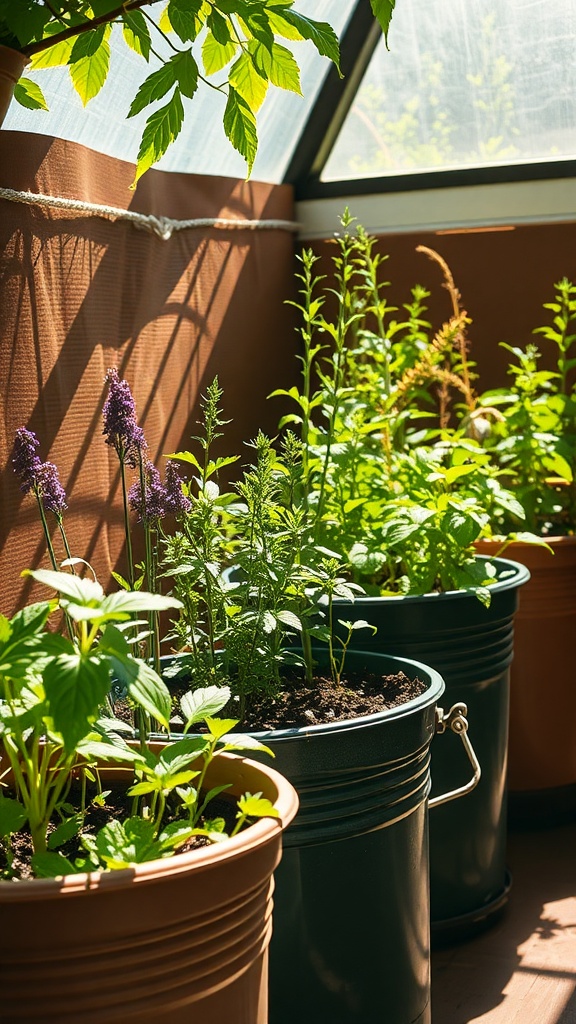
Growing herbs in containers can be a fun and rewarding experience. One of the key factors to consider is sunlight. The image shows various herbs in pots, each receiving different amounts of sunlight. This visual helps illustrate how sunlight affects growth.
Most herbs thrive in full sun, which means they need at least six hours of direct sunlight each day. In the image, you can see how some herbs are positioned to catch the sun’s rays. If your herbs are not getting enough light, they may become leggy and weak.
Some herbs, like parsley and mint, can tolerate partial shade. The image hints at this by showing different types of herbs in various light conditions. If you have a shady spot, consider planting these herbs. They will still grow well, even with less sunlight.
When placing your containers, think about the sun’s path. Herbs need consistent light, so avoid spots where shadows might fall. The image serves as a reminder to observe how sunlight moves throughout the day to find the best location for your herbs.
Soil Types for Optimal Herb Growth
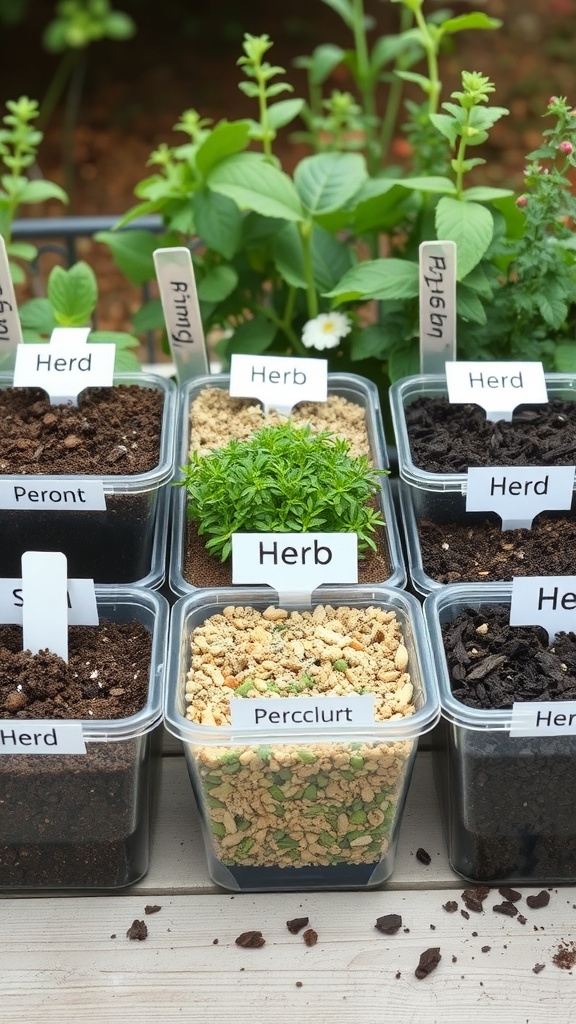
Choosing the right soil for your herb garden is key to growing healthy plants. The image shows various containers filled with different types of soil, each labeled clearly. This setup is perfect for experimenting with what works best for your herbs.
Each soil type has unique properties. For instance, some are more nutrient-rich, while others provide better drainage. Herbs like basil and parsley thrive in well-drained soil, while mint prefers a bit more moisture. By testing different soils, you can find the perfect match for each herb.
Don’t forget to consider adding organic matter. Compost can boost nutrients and improve soil structure. Mixing in some perlite or sand can enhance drainage, especially for herbs that don’t like to sit in water.
In short, the right soil can make all the difference in your herb garden. Take the time to explore these options, and you’ll be rewarded with a bountiful harvest.
Watering Techniques for Container Herbs
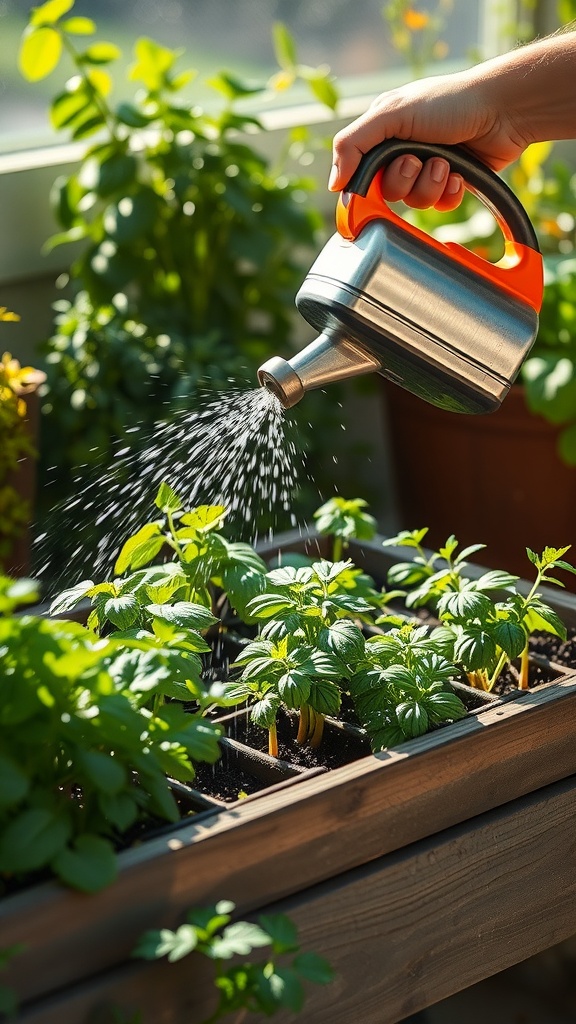
Watering container herbs is key to their growth and health. In the image, a hand holds a watering can, gently showering the plants with water. This simple act is vital for keeping the herbs hydrated and thriving.
When watering, aim for the base of the plants. This helps direct moisture to the roots where it’s needed most. Overhead watering can lead to fungal issues, so it’s best to avoid soaking the leaves.
Check the soil moisture regularly. Stick your finger about an inch into the soil. If it feels dry, it’s time to water. Container herbs often dry out faster than those in the ground, so be attentive.
Consider using a watering can with a narrow spout, like the one shown. It allows for precise watering, minimizing waste and ensuring that each plant gets enough water.
Lastly, always water in the morning or late afternoon. This timing helps reduce evaporation and allows the plants to absorb moisture effectively. Happy watering!
Pest Control in Container Herb Gardens
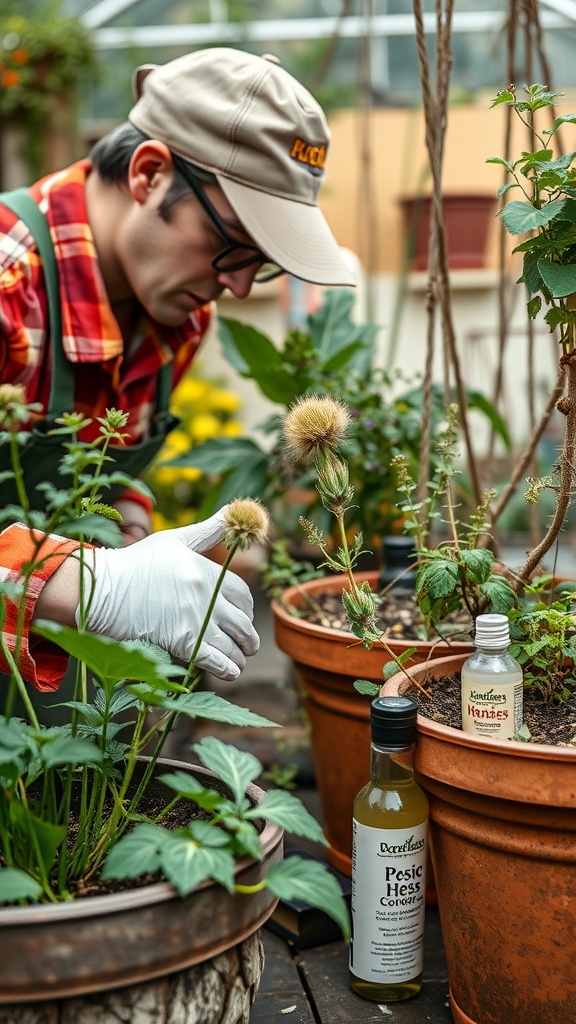
Container herb gardens are a fantastic way to grow fresh herbs right at home. However, pests can be a challenge. In the image, we see a gardener carefully inspecting plants in pots, wearing gloves and focused on keeping the herbs healthy.
One effective method for pest control is to regularly check your plants. Look for any signs of insects or damage. Early detection can save your herbs from serious harm.
Using natural remedies can also help. Sprays made from garlic or neem oil can deter pests without harming your plants. The bottles in the image suggest that the gardener is prepared with solutions to tackle any pest issues.
Another tip is to introduce beneficial insects like ladybugs. They can help keep harmful pests in check. Keeping your herbs healthy with proper watering and sunlight also makes them less appealing to pests.
Remember, a little attention goes a long way in maintaining a thriving container herb garden. Happy gardening!
Fertilizing Container Herbs Effectively
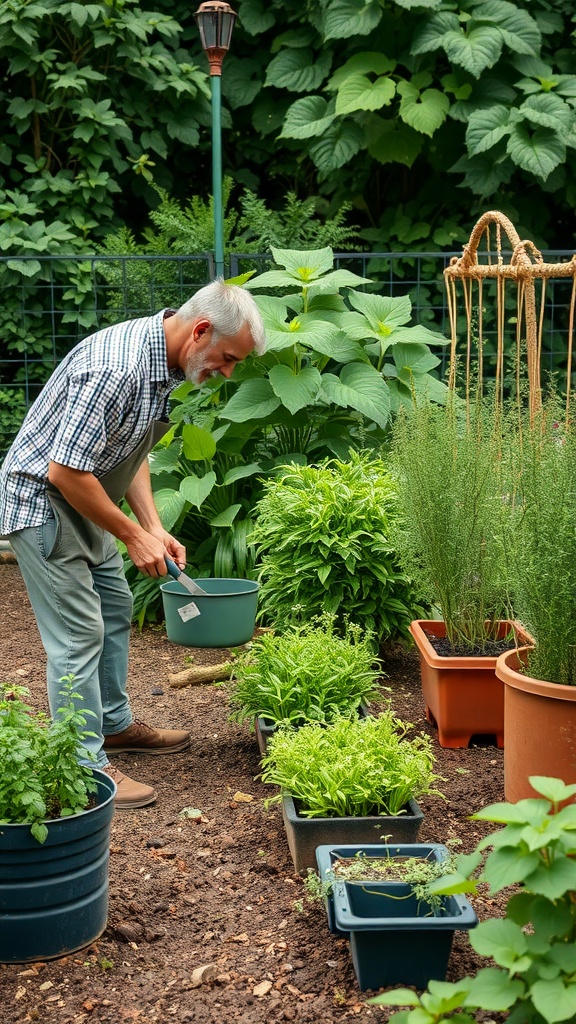
Container herb gardens are a fantastic way to bring fresh flavors to your kitchen. In the image, a gardener tends to various herbs in pots, showing how easy it is to maintain these plants in a small space. The vibrant greenery highlights the joy of growing your own herbs.
When fertilizing your container herbs, it’s important to choose the right type of fertilizer. Organic options like compost or fish emulsion can work wonders. These natural fertilizers provide essential nutrients without overwhelming the plants.
Timing is key. Fertilize your herbs every four to six weeks during the growing season. This helps them thrive and produce flavorful leaves. Just be careful not to over-fertilize, as this can lead to lush foliage but less flavor.
Watering is also crucial. Make sure your herbs are well-hydrated before applying fertilizer. This helps prevent root burn and ensures that the nutrients are absorbed effectively.
Lastly, observe your plants. If they look healthy and vibrant, you’re likely on the right track. If they appear yellow or stunted, it might be time to adjust your fertilizing routine. Happy gardening!
Choosing the Right Containers for Herbs
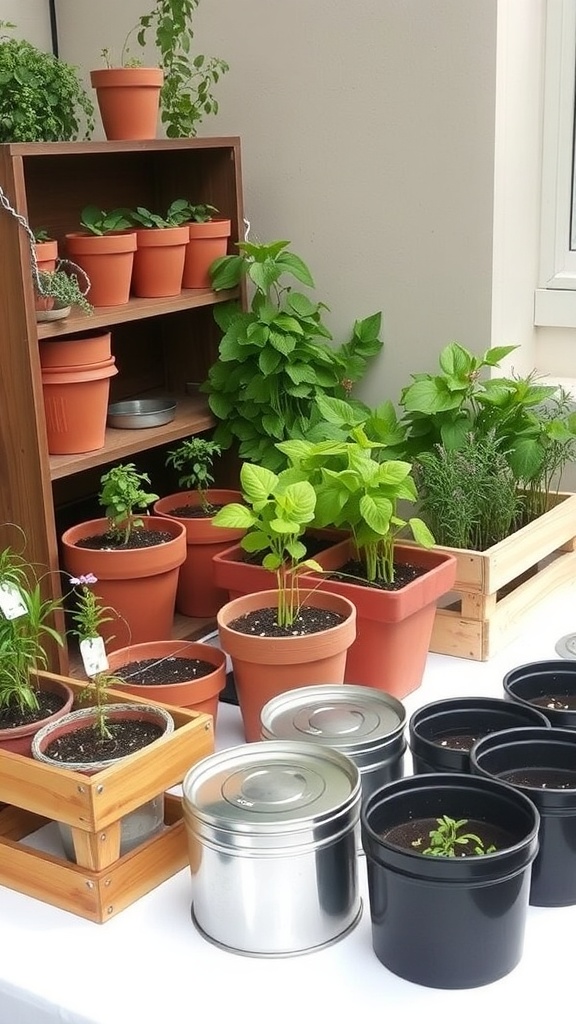
When starting a herb garden in containers, the choice of pots can make a big difference. The image shows a variety of containers, from traditional terracotta pots to modern metal ones. Each type has its own benefits.
Terracotta pots are popular for herbs. They allow for good air circulation and drainage, which is essential for healthy roots. The earthy color also blends well with plants. On the other hand, metal containers can add a contemporary touch to your garden. They are sturdy and often come with lids, making them great for storage.
Wooden boxes, like the one in the image, are another option. They provide a rustic look and can hold multiple plants. Just make sure they are treated to resist moisture. Whichever container you choose, ensure it has drainage holes. This helps prevent overwatering, which can harm your herbs.
Consider the size of your herbs too. Some, like basil and mint, grow tall and need more space. Others, like chives, can thrive in smaller pots. Mixing different sizes can create an interesting display. Don’t forget to have fun with your choices!
Companion Planting in Container Gardens

Container gardens are a fantastic way to grow herbs, and companion planting can make them even better. In the image, you can see a vibrant mix of herbs and plants thriving together in a single pot. This colorful arrangement not only looks appealing but also serves a purpose.
Companion planting involves pairing plants that benefit each other. For example, some herbs can deter pests or enhance the flavor of others. In this container, the lush green leaves and bright yellow flowers suggest a thoughtful selection of plants that work well together.
When you plant herbs like mint or basil alongside others, they can help each other grow. Mint can repel certain pests, while basil can improve the taste of tomatoes if you choose to add them later. Mixing herbs in a container is not just practical; it creates a mini ecosystem that can thrive with minimal effort.
Using containers allows you to control the environment better. You can move them to get the right amount of sunlight or shade. Plus, they can fit into any space—balconies, patios, or even kitchen windowsills. So, if you’re looking to start your own herb garden, consider companion planting in containers for a beautiful and productive setup.
Creating a Vertical Herb Garden
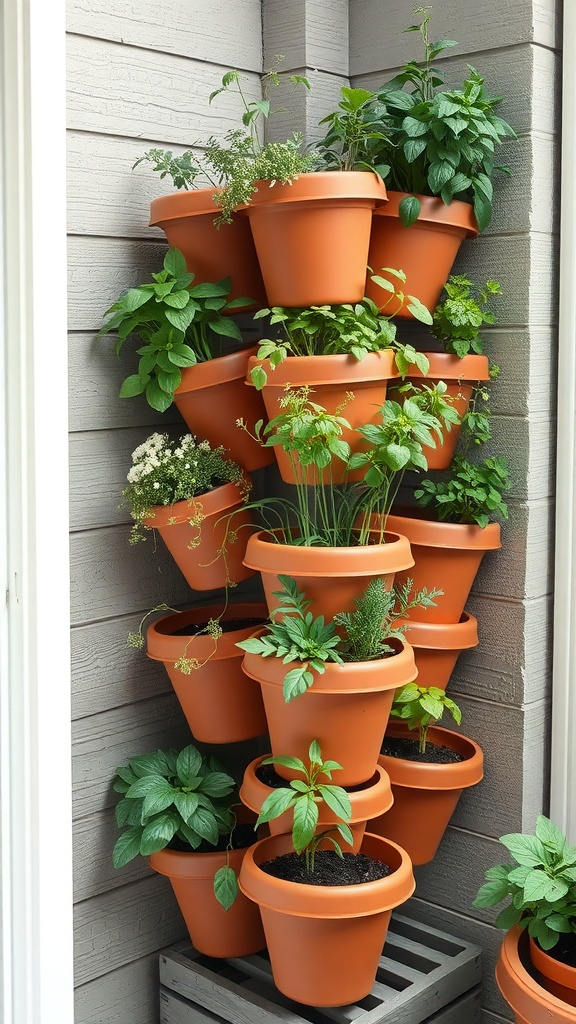
Vertical herb gardens are a fantastic way to maximize space while adding greenery to your home. The image shows a neatly arranged stack of terracotta pots, each filled with a variety of herbs. This setup not only looks appealing but also makes it easy to care for your plants.
Using vertical space is perfect for small areas like balconies or kitchens. The pots are positioned in a way that allows sunlight to reach each plant, ensuring they thrive. You can grow herbs like basil, mint, and rosemary, which are great for cooking and adding flavor to your dishes.
To create your own vertical garden, start by choosing a sunny spot. Stack your pots securely, ensuring they are stable. Fill each pot with quality potting soil and select your favorite herbs. Water them regularly, and soon you’ll have a beautiful and functional herb garden right at home!
Herb Garden Maintenance Tips
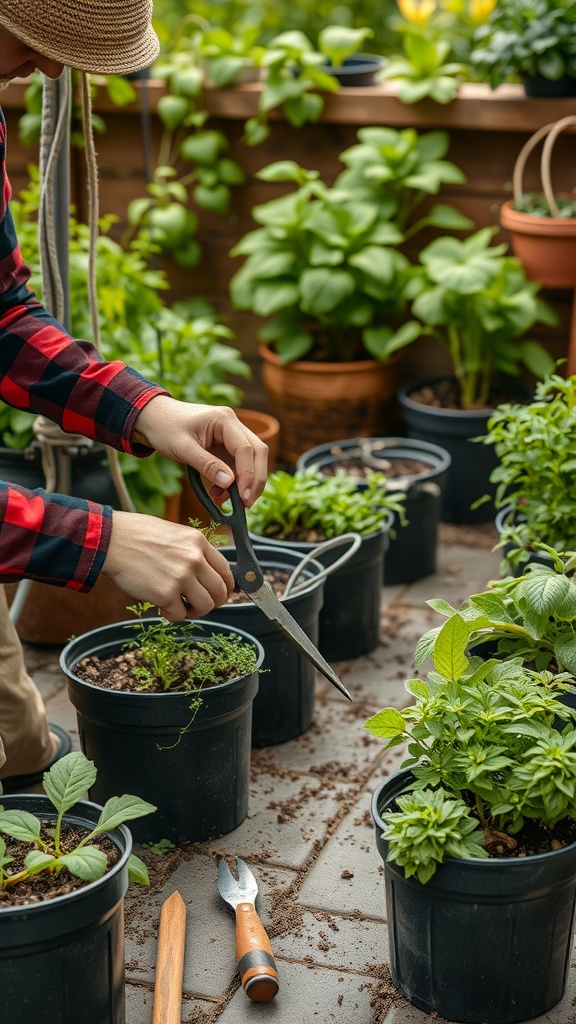
Maintaining a container herb garden is a fun and rewarding task. In the image, we see someone carefully pruning herbs in pots. This simple act is key to keeping your plants healthy and productive.
Regular pruning helps encourage new growth and prevents overcrowding. Use clean, sharp scissors to snip off dead or overgrown leaves. This not only keeps your herbs looking neat but also enhances their flavor.
Watering is another important aspect. Check the soil moisture regularly. Herbs in containers may dry out faster than those in the ground. Make sure to water them when the top inch of soil feels dry.
Fertilizing your herbs can also boost their growth. Use a balanced, organic fertilizer every few weeks during the growing season. This gives your plants the nutrients they need to thrive.
Lastly, don’t forget about sunlight! Most herbs love bright light, so place your containers in a sunny spot. If you notice your herbs stretching towards the light, they might need more sun.
Using Herbs in Culinary Creations
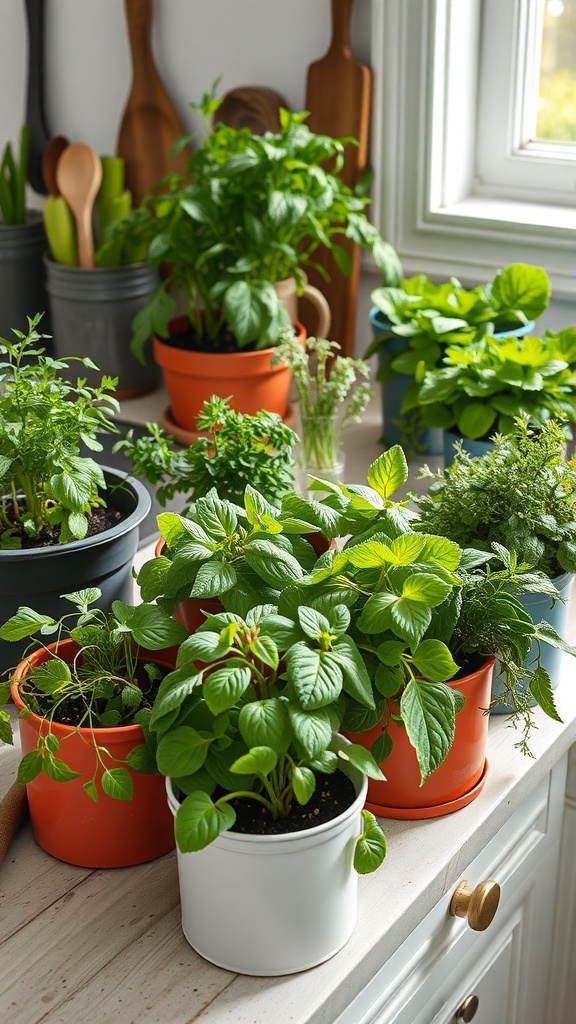
Herbs bring a burst of flavor and freshness to any dish. In the image, you can see a variety of herbs growing in colorful containers. These herbs are not just for decoration; they are essential ingredients in many recipes.
Imagine snipping fresh basil for a homemade pesto or adding a sprinkle of parsley to brighten up a soup. Having herbs on hand makes it easy to elevate everyday meals. You can grow herbs like mint, cilantro, and thyme right in your kitchen.
Using herbs is simple. Just pick a few leaves, chop them up, and mix them into your favorite dishes. They can be added to salads, marinades, or even desserts for a unique twist. The best part? Growing your own herbs means you can enjoy them fresh whenever you want.
So, if you’re looking to enhance your culinary creations, consider starting a small herb garden in containers. It’s a fun and rewarding way to bring more flavor to your cooking!
Herb Harvesting Techniques for Containers
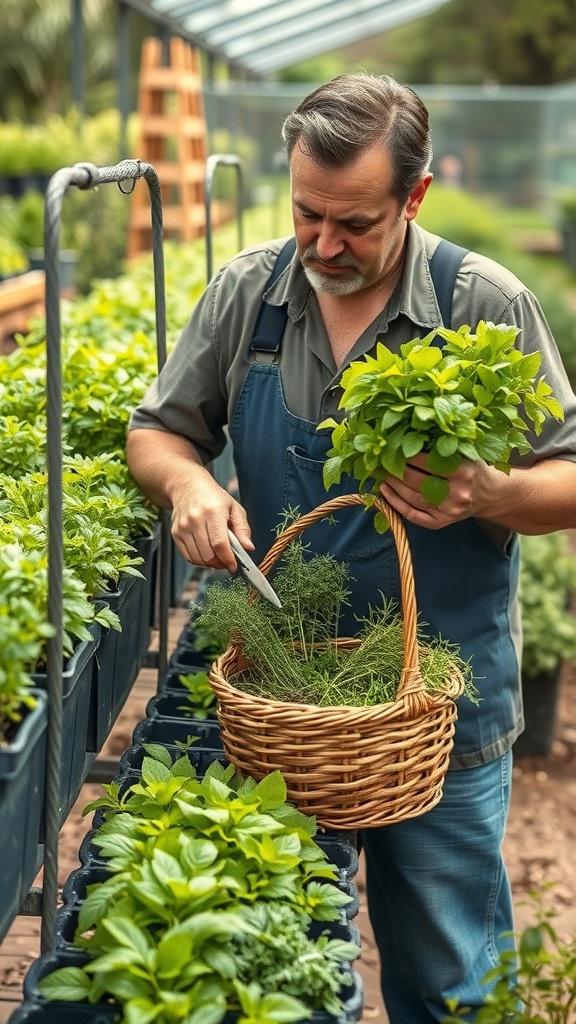
Harvesting herbs from your container garden can be a rewarding experience. The image shows a person carefully snipping herbs with scissors while holding a basket. This method is perfect for gathering fresh ingredients for your meals.
When you’re ready to harvest, make sure to choose a sunny day. This helps the herbs retain their flavor. Use clean, sharp scissors to avoid damaging the plants. Cut just above a leaf node to encourage new growth.
It’s best to harvest in the morning when the oils in the herbs are at their peak. This ensures you get the most flavor. Always leave enough leaves on the plant so it can continue to grow.
After harvesting, rinse the herbs gently to remove any dirt or bugs. Pat them dry with a clean towel before using or storing. Fresh herbs can elevate any dish, so enjoy the fruits of your labor!
DIY Container Herb Garden Ideas

Creating a container herb garden is a fun and rewarding project. The image shows a variety of herbs in stylish containers, making it easy to grow fresh ingredients right at home. You can see herbs like basil, mint, and others thriving in different pots.
Using containers allows you to customize your garden space. You can choose pots that match your home decor or go for a rustic look with vintage cans. This flexibility makes it easy to find a style that suits you.
Start by selecting your favorite herbs. Basil is great for pasta dishes, while mint can add a refreshing twist to drinks. Make sure to use quality potting soil and provide enough sunlight for your plants. Water them regularly, and soon you’ll have a mini herb garden bursting with flavor!
Seasonal Herb Planting Strategies
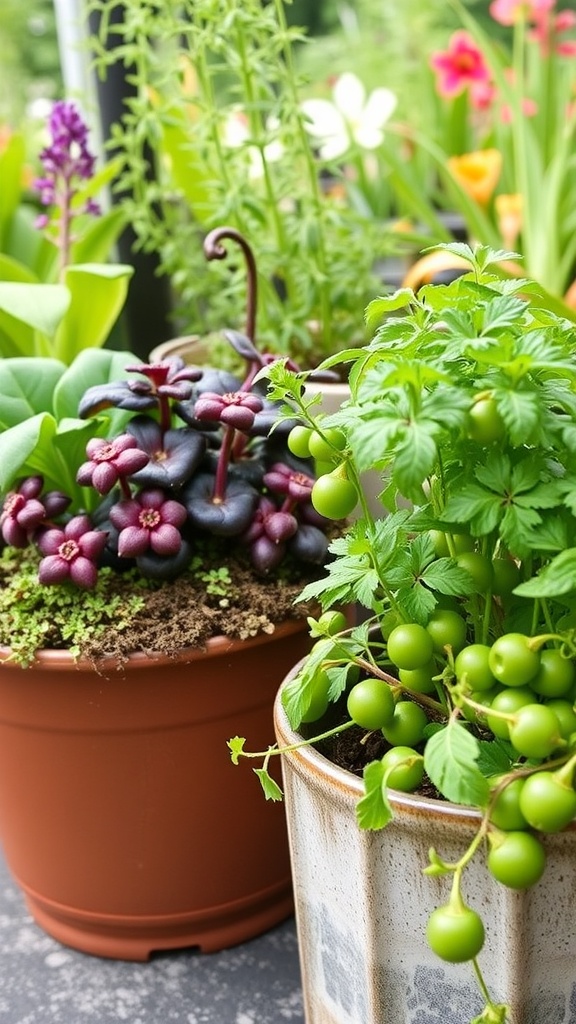
Container herb gardens are a fantastic way to enjoy fresh flavors right at home. The image shows a variety of herbs planted in colorful pots, alongside a planting calendar. This calendar is a handy guide for knowing when to plant each herb throughout the seasons.
Spring is a great time to start planting herbs like basil and cilantro. These herbs thrive in warmer weather and can be used in many dishes. As the weather warms up, you can also consider planting rosemary and thyme, which love the sun.
In summer, keep an eye on your herbs. Regular watering is key, especially for those in containers. You might want to add some mint or dill, which can flourish during these months. The calendar can help you track when to sow seeds or transplant young plants.
As fall approaches, it’s time to think about harvesting. Many herbs can be cut back to encourage new growth. You can also start planting cold-tolerant herbs like parsley and chives, which can survive the cooler temperatures.
Winter might seem like a tough time for herbs, but some can still thrive indoors. Using the calendar, you can plan for indoor herbs like oregano and sage. They can bring a touch of green to your kitchen during the colder months.
Herb Garden Layouts for Small Spaces
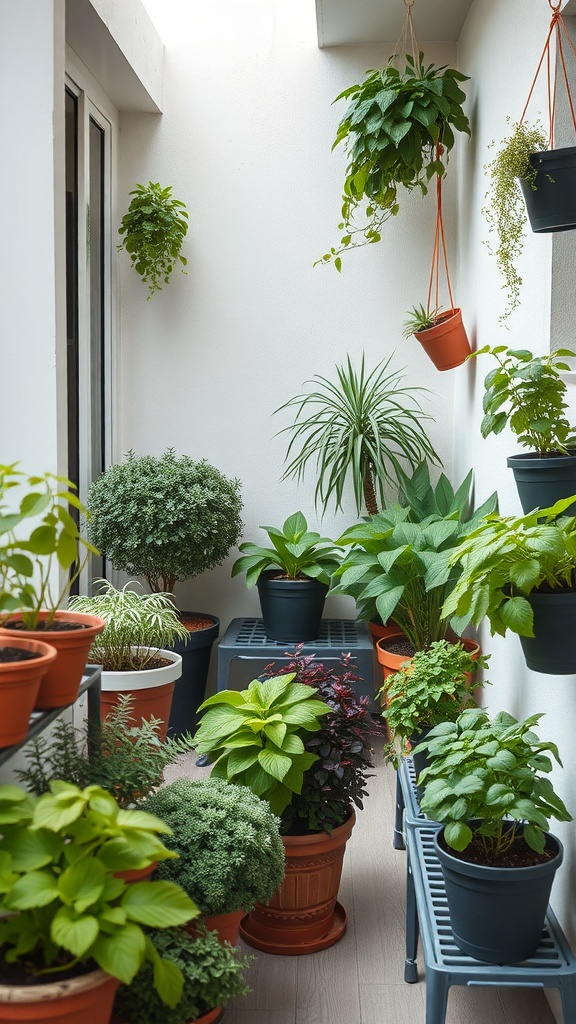
Creating a herb garden in a small space can be both fun and rewarding. The image shows a cozy balcony filled with various plants in containers. This setup is perfect for anyone looking to grow herbs without needing a large yard.
Notice how the plants are arranged in a way that maximizes space. Some are on shelves, while others hang from the wall. This vertical gardening approach allows for more herbs without crowding the area. You can easily grow favorites like basil, mint, and parsley in pots.
Using different sizes and colors of containers adds visual interest. Mixing textures and heights makes the garden feel lively and inviting. You can choose pots that match your style, whether it’s rustic clay or sleek modern designs.
Don’t forget about sunlight! Position your herbs where they can soak up the sun. If your space is shaded, consider herbs that thrive in lower light, like chives or lemon balm.
With a little creativity, even the smallest balcony can become a thriving herb garden. Enjoy the process of planting and watching your herbs grow!
Maintaining Container Herbs During Winter
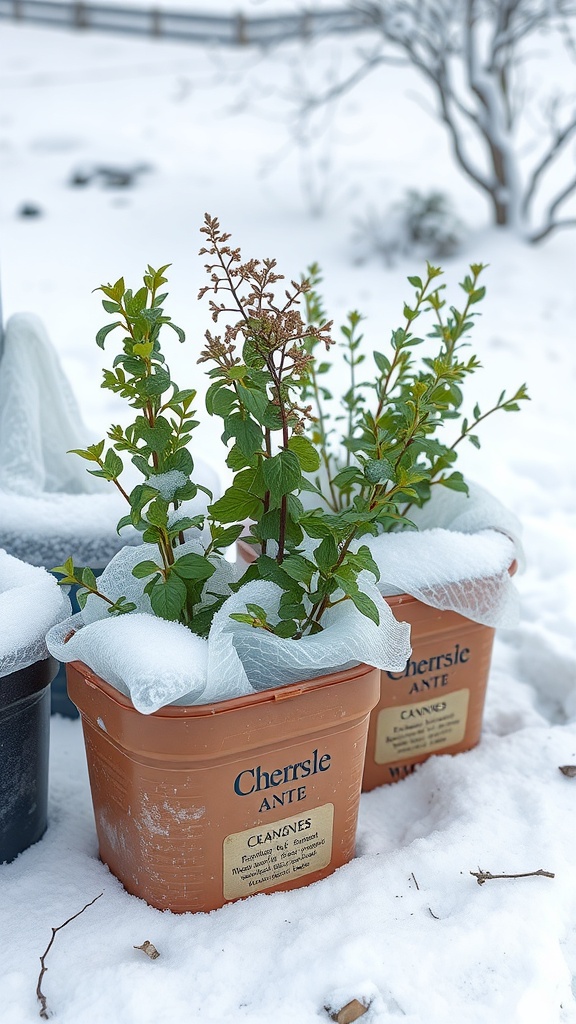
Winter can be tough on container herbs, but with a little care, they can thrive even in the cold. The image shows a couple of pots with herbs, snugly wrapped to protect them from the snow. This setup is a great example of how to keep your herbs safe during chilly months.
First, consider insulation. Wrapping the pots with burlap or bubble wrap helps keep the roots warm. This is especially important for herbs like basil and mint, which are sensitive to frost. The pots in the image are covered with a protective layer, showing a smart approach to winter care.
Next, think about location. Placing your pots in a sheltered spot can shield them from harsh winds and extreme cold. A sunny corner can also help, as sunlight can warm the pots during the day. The herbs in the photo seem to be in a good spot, enjoying some natural protection.
Watering is another key factor. Even in winter, herbs need moisture. Check the soil regularly; if it feels dry, give them a drink. Just be careful not to overwater, as this can lead to root rot. The herbs in the image look healthy, which suggests they are getting the right amount of care.
Lastly, don’t forget to monitor for pests. Even in winter, some bugs can be a nuisance. Keep an eye out for any signs of trouble. With these simple steps, your container herbs can survive and even thrive through the winter.
Herb Garden Design Aesthetics
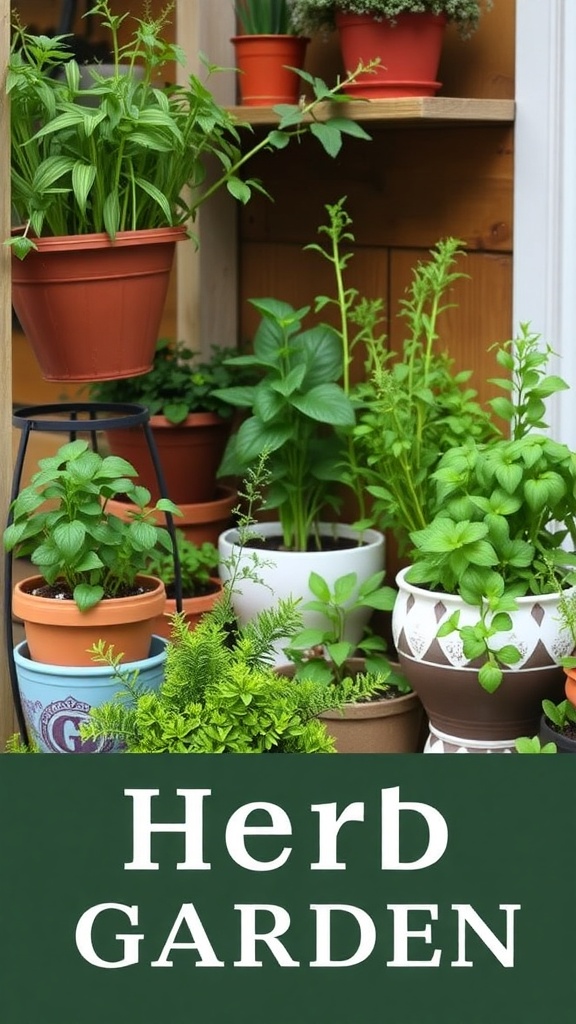
Creating a herb garden in containers is a delightful way to bring greenery into your space. The image showcases a vibrant collection of herbs in various pots, each adding its own charm. The mix of colors and textures creates a lively atmosphere.
Container gardening allows for flexibility in design. You can choose pots that match your style, whether it’s rustic terracotta or sleek modern ceramics. This variety not only enhances the visual appeal but also lets you express your personality.
Arranging the pots at different heights, like using a plant stand, adds depth to the garden. It draws the eye and makes the space feel more dynamic. Grouping herbs with similar needs together can also create a cohesive look while ensuring they thrive.
Don’t forget about the herbs themselves! Each plant has its own unique shape and color, contributing to the overall aesthetic. Mixing leafy greens with flowering herbs can create a stunning display. Plus, having fresh herbs on hand for cooking is a bonus!
Herbs for Attracting Pollinators in Containers

Creating a container herb garden can be a delightful way to attract pollinators. The image shows a vibrant mix of flowers and herbs, buzzing with bees. This lively scene highlights how herbs can serve a dual purpose: providing fresh flavors for your kitchen while also supporting local wildlife.
Consider planting herbs like basil, mint, and thyme. These not only add great taste to your meals but also draw in bees and butterflies. The bright flowers in the container, like daisies and purple blooms, further enhance the appeal for these important pollinators.
When arranging your container, mix herbs with flowering plants. This combination creates a visually stunning display while ensuring that pollinators have plenty to visit. Remember to choose a sunny spot for your container, as most herbs thrive in bright light. With a little care, your herb garden can become a buzzing hub of activity!
Integrating Herbs into Home Decor
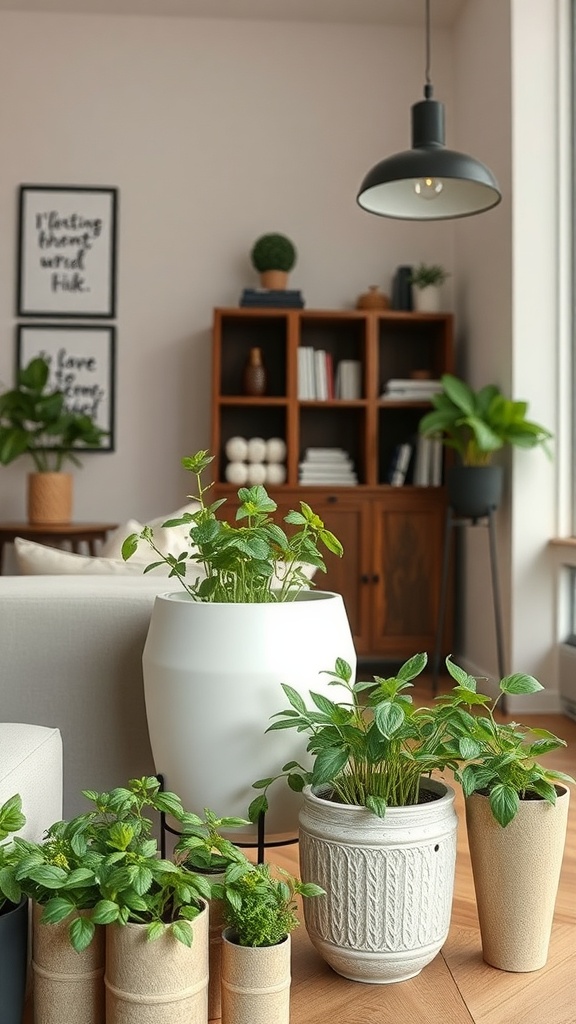
Herbs can bring life to any space, and using containers is a fantastic way to incorporate them into your home decor. The image shows a cozy room filled with various herb plants in stylish pots. Each container adds a unique touch to the decor, making the space feel fresh and inviting.
In the foreground, smaller pots hold herbs like mint and basil, perfect for cooking. Their vibrant green leaves stand out against the neutral tones of the room. The larger white pot in the back adds a modern flair, showcasing a taller herb, perhaps rosemary or parsley. This mix of sizes and styles creates visual interest.
Not only do these herbs look great, but they also serve a practical purpose. Having fresh herbs on hand can inspire you to cook more and enjoy the flavors they bring. Plus, they can improve air quality, making your home feel even more comfortable.
Consider placing your herb containers near a window where they can get plenty of sunlight. This setup not only benefits the plants but also enhances the overall look of your living space. Mixing herbs with other decorative elements, like framed quotes or bookshelves, creates a harmonious blend of nature and style.
Herbs for Medicinal Uses in Containers
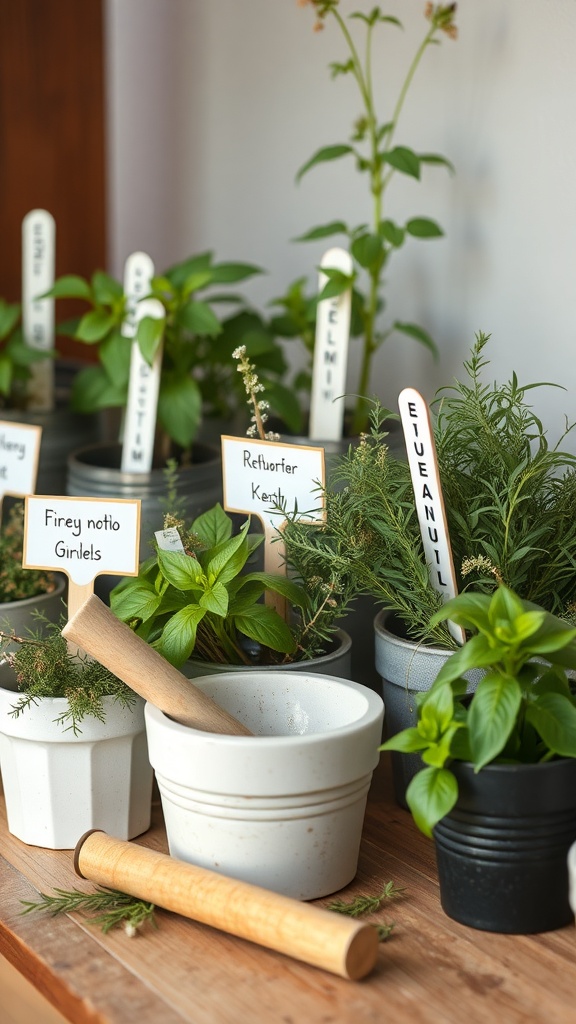
Growing herbs in containers is a great way to have fresh, medicinal plants right at your fingertips. The image shows a variety of herbs, each labeled for easy identification. This setup is perfect for anyone looking to incorporate natural remedies into their daily routine.
Some popular medicinal herbs include basil, rosemary, and mint. Each of these herbs has unique properties. For example, basil can help with digestion, while rosemary is known for its anti-inflammatory benefits. Mint is refreshing and can soothe headaches.
Using a mortar and pestle, as seen in the image, is a fun way to prepare your herbs. You can crush them to release their essential oils, making them more potent for teas or topical applications. Growing these herbs in containers allows you to manage their needs easily, ensuring they thrive.
Container gardening also means you can move your herbs to catch the best sunlight or protect them from harsh weather. This flexibility is key to keeping your plants healthy and productive. So, whether you’re a seasoned gardener or just starting, growing medicinal herbs in containers is a rewarding and practical choice.
Herb Garden Innovations and Trends
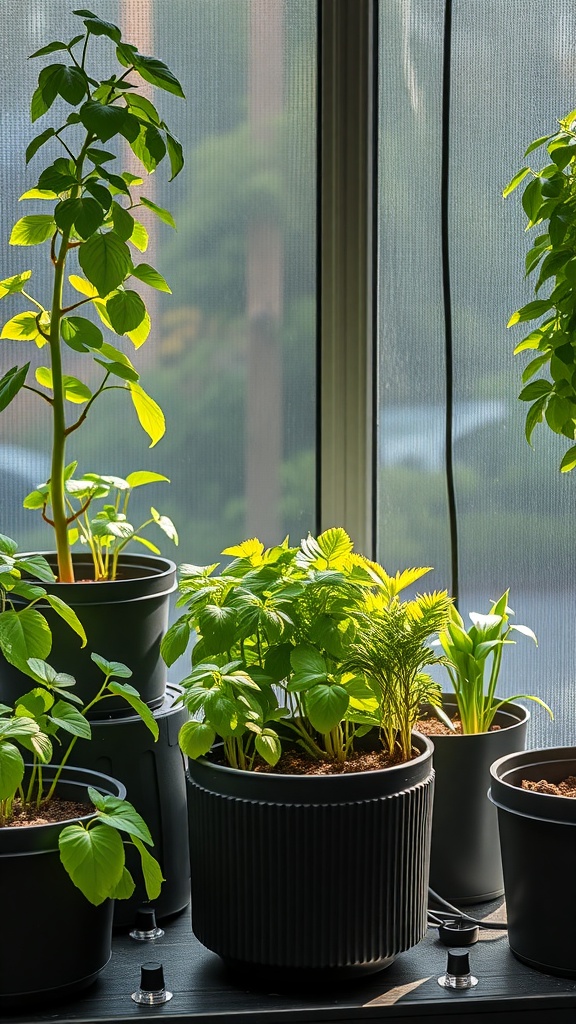
Container herb gardens are gaining popularity, especially for those with limited space. The image shows a variety of herbs thriving in stylish pots, showcasing how easy it is to grow fresh ingredients indoors.
These innovative setups allow for creativity and personalization. You can mix and match different herbs like basil, parsley, and dill, creating a mini herb paradise right in your kitchen. The sleek, modern pots add a touch of elegance, making them perfect for any home decor.
With advancements in gardening technology, many are turning to self-watering containers. These make it simpler to maintain the right moisture levels, ensuring your herbs grow strong and healthy. Plus, they reduce the hassle of daily watering.
Indoor gardening is not just a trend; it’s a lifestyle choice. Growing your own herbs means you can enjoy fresh flavors in your cooking while also bringing a bit of nature indoors. It’s a fun way to connect with your food and enhance your meals.
Herbs That Thrive in Shady Areas
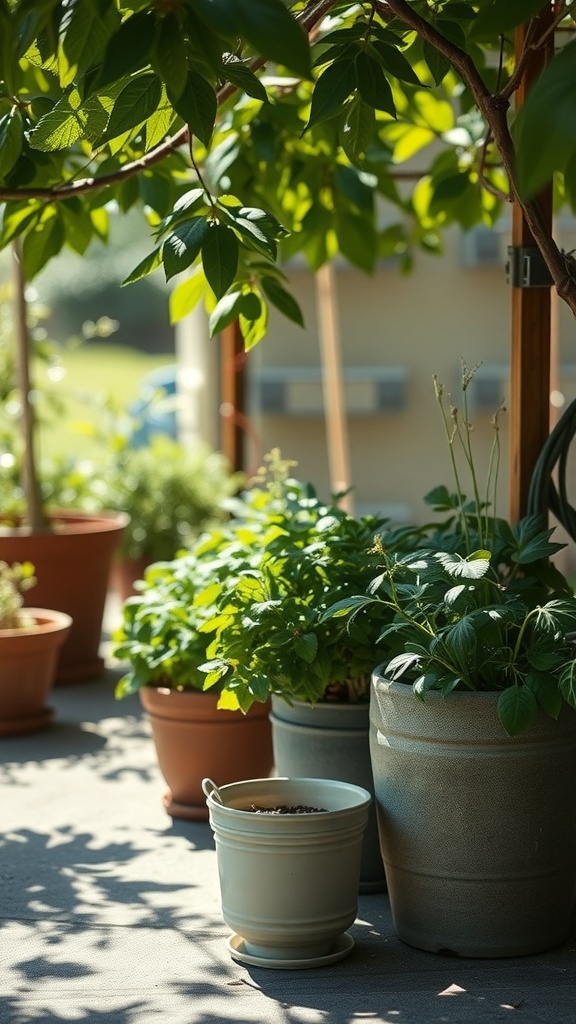
Creating a herb garden in containers is a great way to enjoy fresh flavors, even in shady spots. The image shows a cozy arrangement of pots filled with vibrant herbs, all thriving under the dappled light of a tree. This setup is perfect for those who may not have full sun but still want to grow their own herbs.
Some herbs that do well in partial shade include mint, parsley, and chives. Mint, with its refreshing aroma, can spread quickly, so it’s best to keep it in its own pot. Parsley is another fantastic choice, adding a pop of green and a burst of flavor to dishes. Chives, with their delicate onion-like taste, are perfect for garnishing salads and soups.
Container gardening allows you to easily move your herbs around to find the best spot for them. If you notice your herbs aren’t thriving, simply shift the pots to catch a bit more light. This flexibility makes container gardening a fun and rewarding experience.
